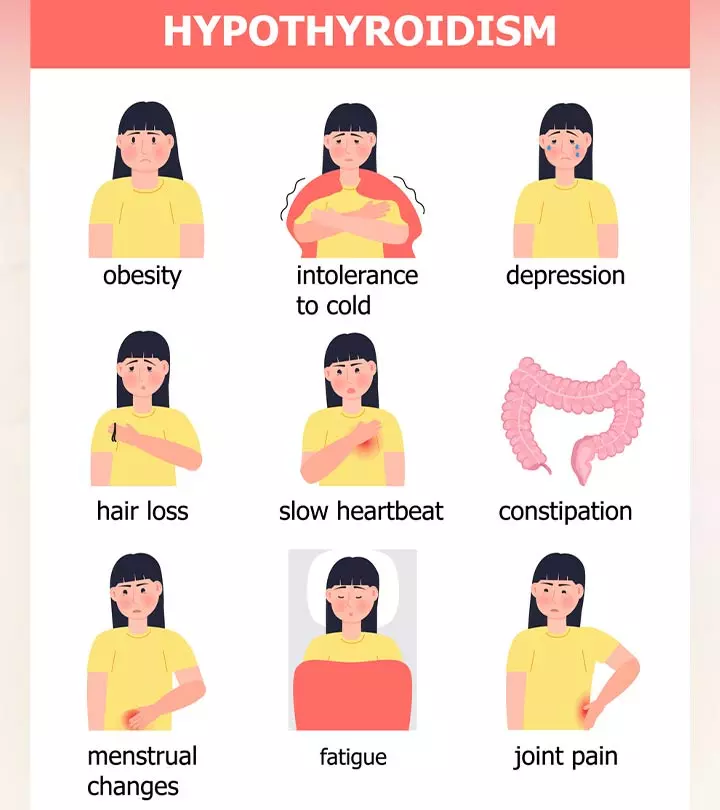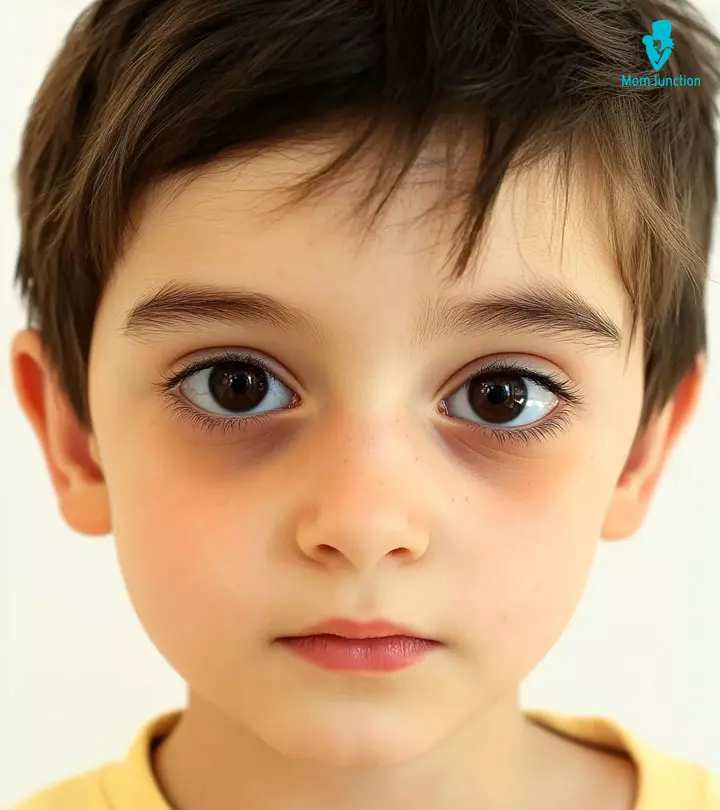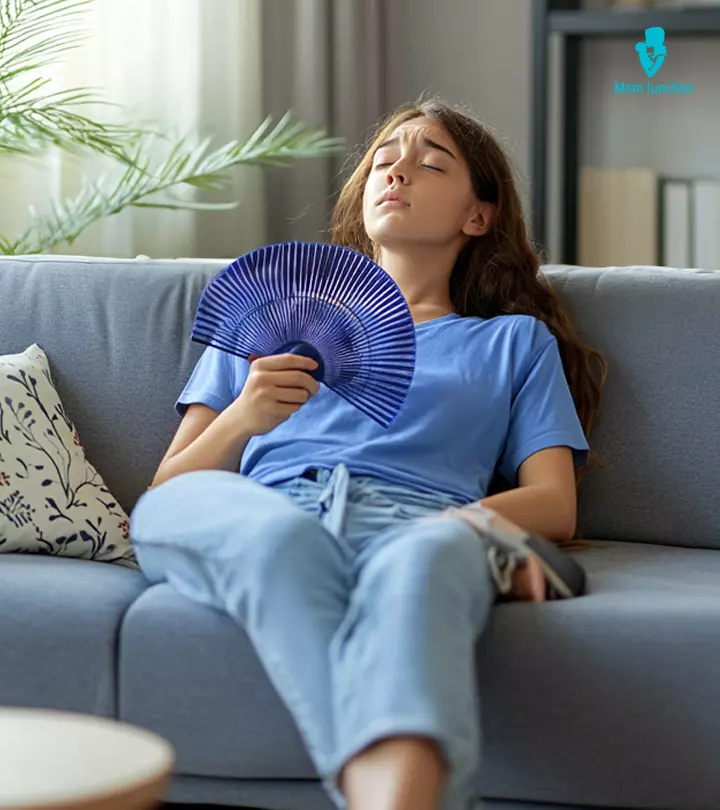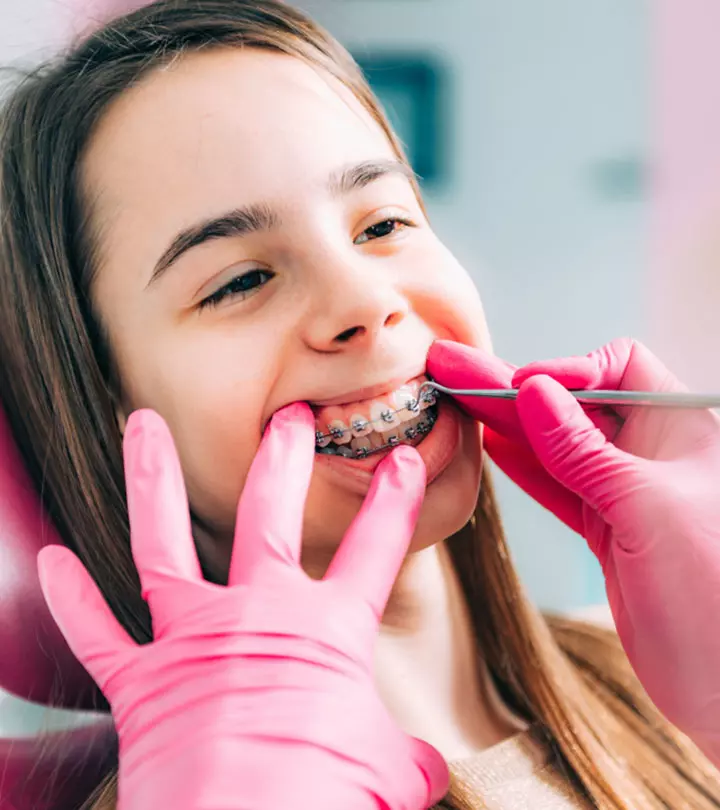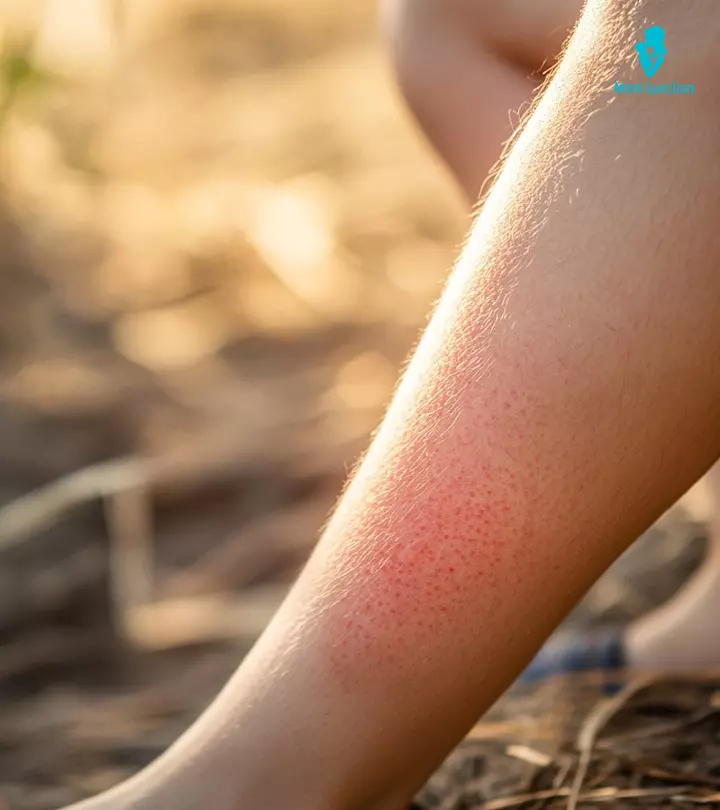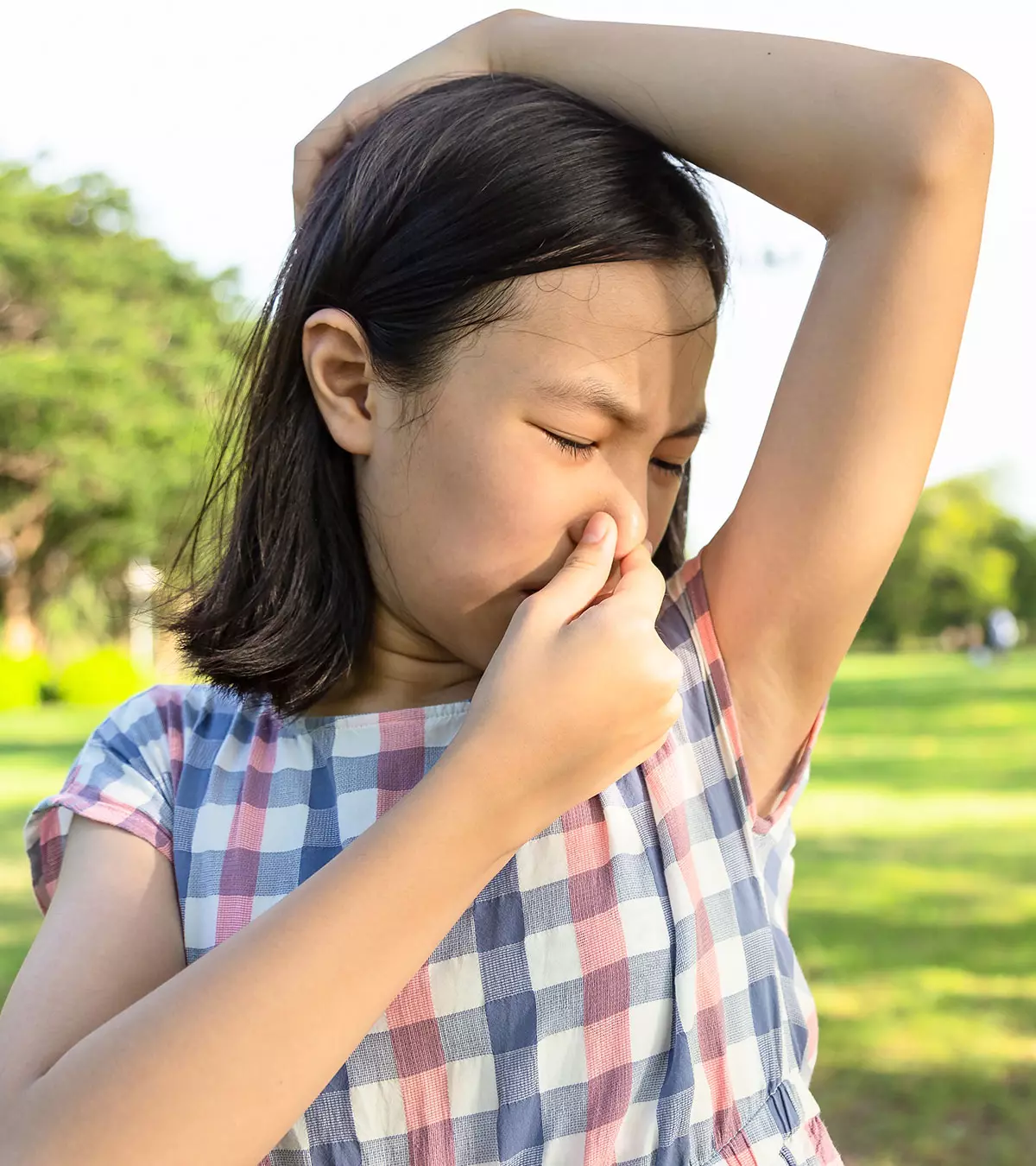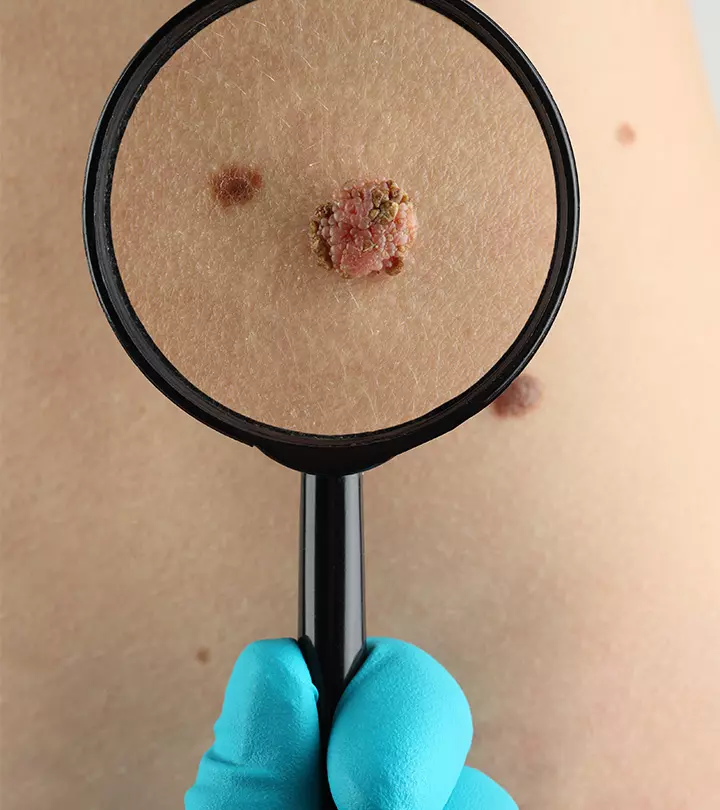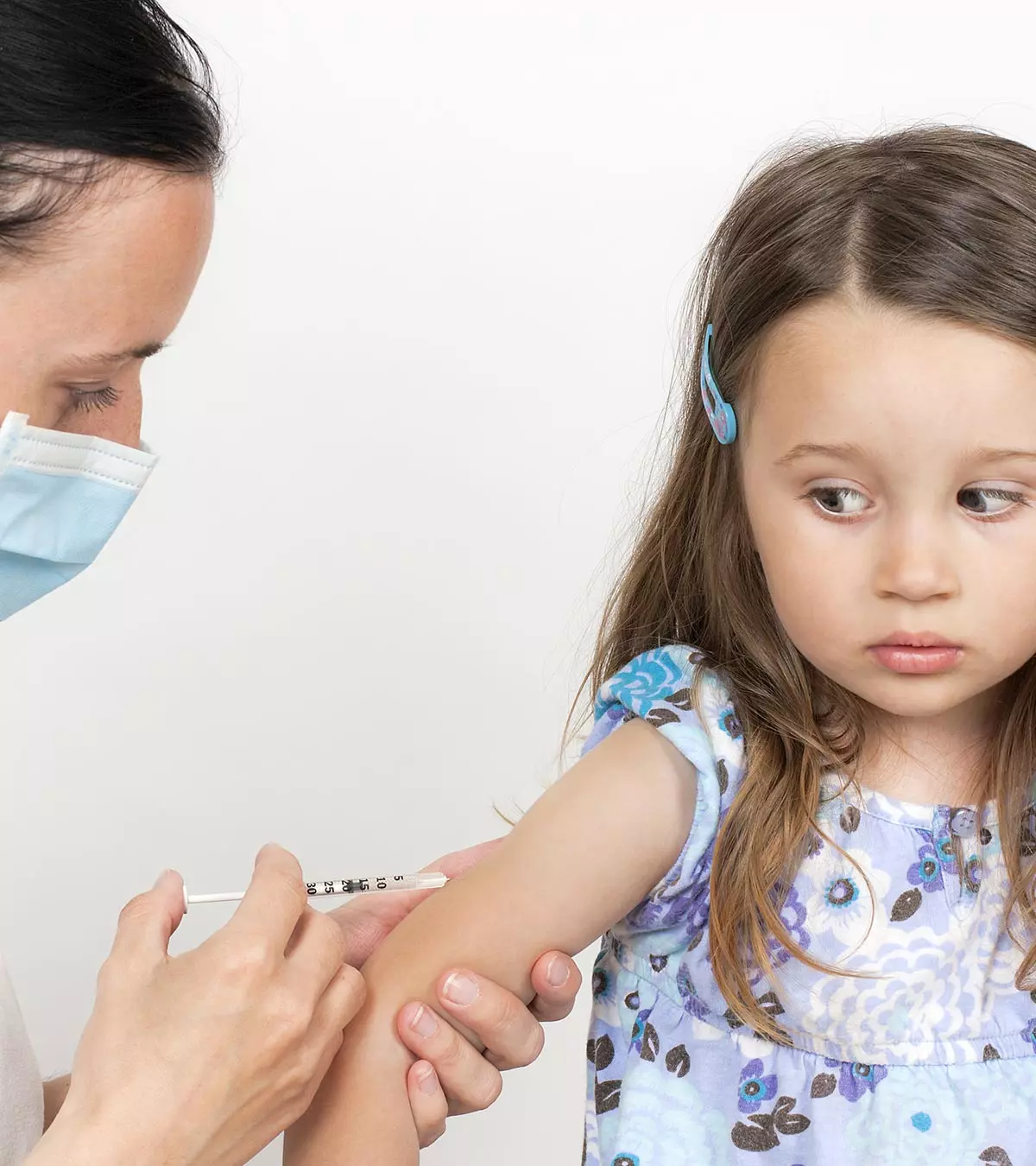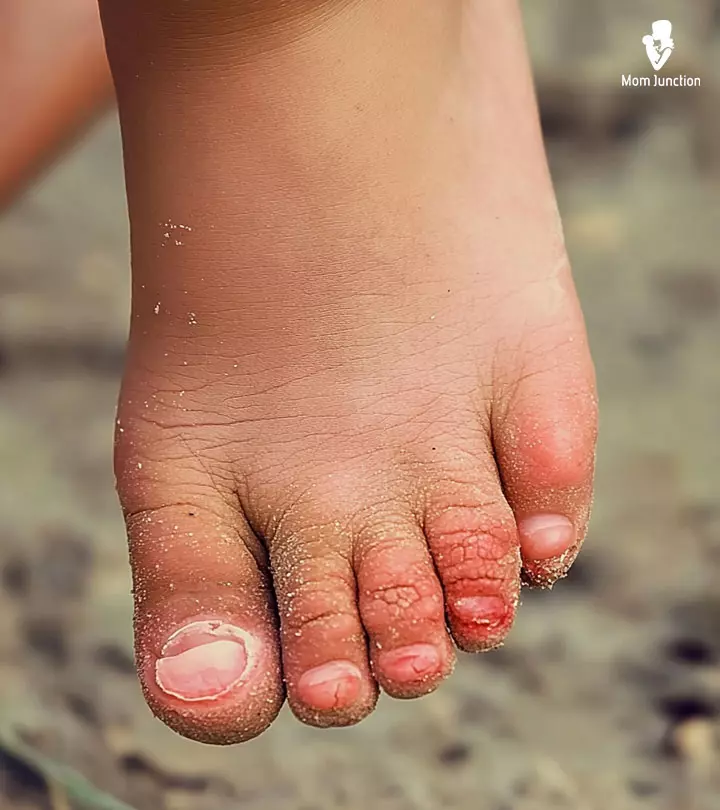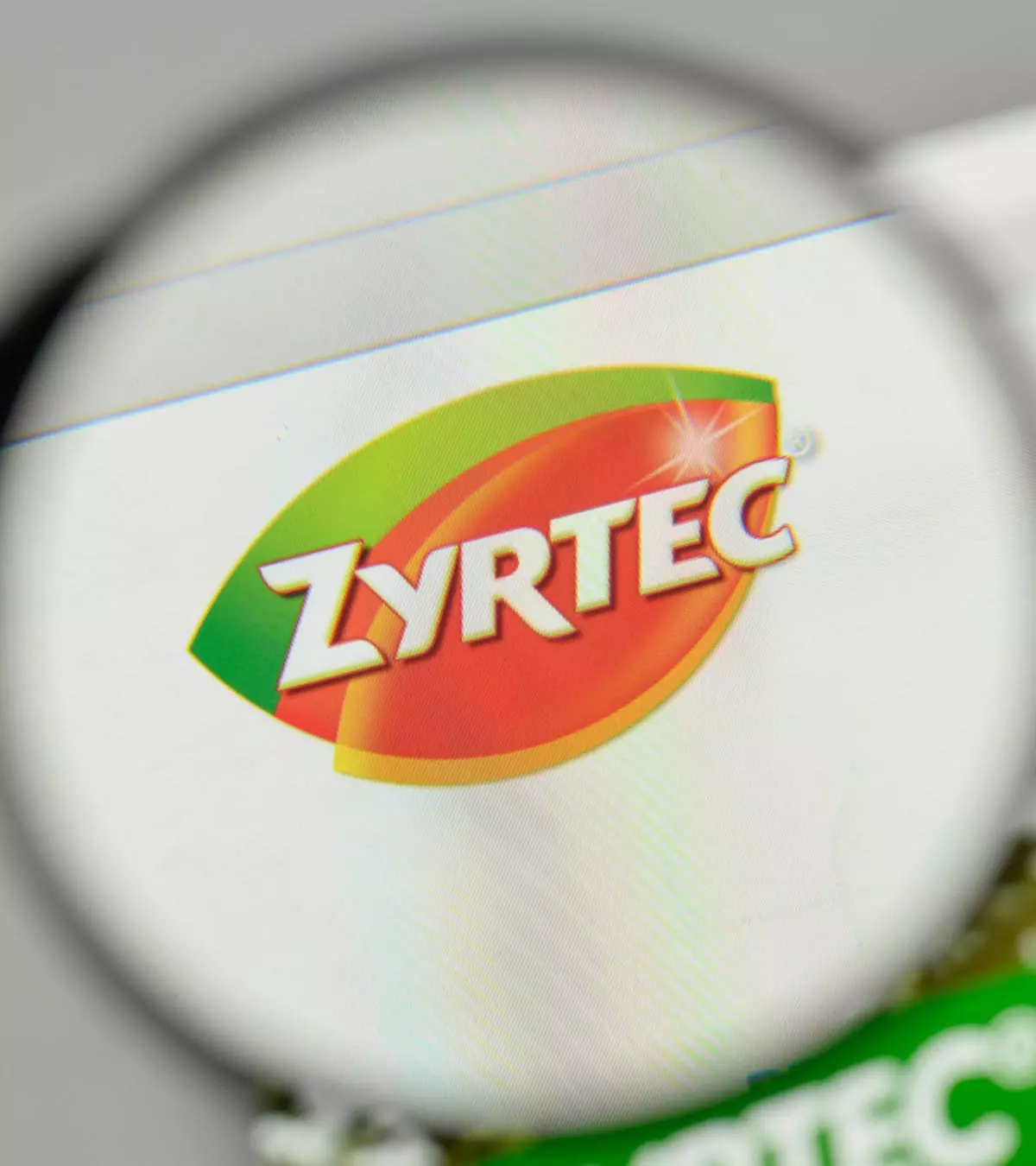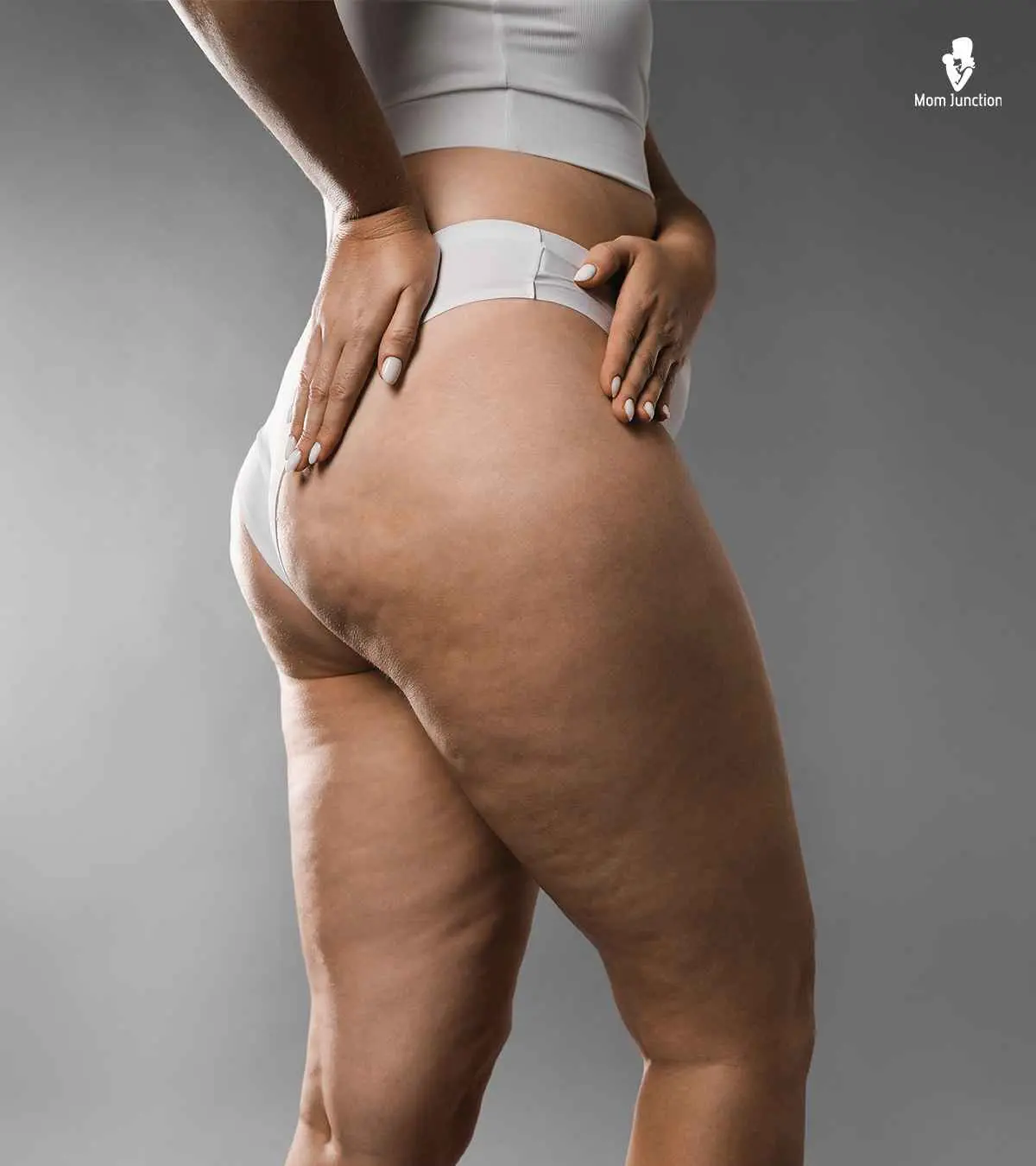
Image: Shutterstock
Cellulite in teens is not a medical concern and requires no medical treatments. Although it is harmless, a lumpy or dimpled or orange-peel appearance of the skin can be an aesthetic concern for many people. You may notice this skin changes commonly on the abdomen, hips, buttocks, and thighs. Nearly 80 to 90 percent of postpubertal women can have cellulite, which is comparatively rare in boys (1) (2).

You may try some home remedies, lifestyle changes, and aesthetic measures to improve the appearance of the skin. You may consult a board-certified dermatologist for personalized advice. Read on to know more about the causes, home remedies, and other treatments and their effectiveness for cellulitis in teens.
Key Pointers
- Cellulite is often visible in the thighs, hips, and buttocks.
- Common causes of cellulite in teenagers include family history, fluid buildup, and bulging of fat tissue.
- Cellulite can be managed through weight loss, using anti-cellulite creams and lotions, and undergoing laser and radiofrequency treatments.
- The use of supplements, cryolipolysis, and mesotherapy are not recommended for treating cellulite in teenagers.
- Staying well-hydrated, following a healthy diet, and exercising regularly may help prevent cellulite in some cases.
Causes Of Cellulite In Teens
The exact cause of cellulite is unknown. Cellulite is neither a disease nor a sign or symptom of internal medical issues. However, many tend to believe myths suggesting cellulite in teens is caused by laziness, certain toxins, etc.
The following factors are believed to contribute to the development of cellulite (2).
- Distortion of skin fat: The fibrous bands formed by cellulite tend to connect the muscles to the skin, tightening it and causing an out-pouching of subcutaneous fat or adipose tissue. It is significantly more pronounced in females due to parallel connective bands instead of the crisscross bands in males (7).
- Fluid accumulation: When the lymphatic system fails to remove excess fluid from tissues, it builds up in the gap between cells. Fluid accumulation from lymphatics and microcirculation causes pressure on the subcutaneous tissues, making the skin look lumpy and puckered like an orange peel (13).
- Hormonal factors: Estrogen hormone levels may have a role in cellulite development since it is rare in men and prepubescent and menopausal women. Hormonal changes during puberty can lead to fluctuations in body fat distribution and contribute to the appearance of cellulite. Medical expert Dr. Po-Chang Hsu explains, “One of the main reasons cellulite appears during the teen years is hormonal changes. As puberty begins, rising estrogen levels influence fat distribution, leading to cellulite on the thighs, hips, and buttocks. It’s not about weight—these changes occur even in active teens with a healthy diet.”
- Family history: Studies indicate that cellulite is most common in people with family members having the condition. The development of cellulite has been linked to certain genetic features such as metabolic rate, skin structure, fat distribution, and the structure and function of connective tissues (13).
- Racial factors: The incidence of cellulite was increasingly noticed among Caucasians compared to European, Asian, and African populations (14). Studies indicate that Latin American women had more cellulite around their hips and thighs (15).
Cellulitis may occur in a physically active and fit person. While obesity in teens has scientifically been linked with cellulitis, it does not always happen in those who are overweight or have a high body mass index (BMI). It may be due to differences in adipose tissue and lymphatic flow between individuals who are obese or overweight. However, research indicates that obese males are more likely to develop cellulitis than females. As a result, exercise and diet are less likely to be directly linked to the condition (16).
When To See A Doctor

Although cellulite does not cause physical harm, some teens may be concerned about its appearance, affecting their self-image and self-esteem. If your teen is struggling with these issues, you may consult a dermatologist or primary care physician before attempting any cosmetic procedures. It will help you find safe and appropriate treatment for your teen’s needs and concerns.
Sharing about her battle with cellulite and poor self-perception, Andrea Juárez writes, “When I was 13, I was a few pounds overweight — I weighed 70 kg, I’m 1.67 cm tall — and my mom suggested I started working out since she saw a spot of cellulite in my left leg… I joined a Zumba class, had Herbalife milkshakes for dinner and went to a nutritionist who gave me an incredible diet…But the healthier I ate, the more anxious I felt. Nine out of ten times, I ended up binge eating. Everything in my life was okay: I had (and still do) a great, supportive family and friends, and my school notes were fine, but I couldn’t help being self-conscious.” Andrea elaborates on how going through stages of healthy eating, detox diets, exercising, binge eating, and drinking contributed to self-consciousness, anxiety, tendinitis, and acid stomach. However, with the right inspiration, she finally gained self-acceptance as an adult (ii).
Treatment For Cellulite In Teens
There is a wide range of cosmetic treatments to improve skin appearance. It is important to note that although some may have temporary results, most of these treatments are not a cure and can lead to side effects. Combination treatment methods for cellulite in teens usually have more positive outcomes.
You may choose any of the following treatment modalities, after consulting a certified dermatologist. According to the American Academy of Dermatology, the most effective treatment options for cellulitis include (3):
1. Weight loss
Weight loss may help make the cellulite less noticeable in some people. However, loose skin due to weight loss may make it more visible in a few cases. Seek expert help for an adequate weight loss plan for your teen.
2. Exercise

Physical activity helps replace the fat tissue with muscles and thus may make cellulite less noticeable.
Recalling her personal experience in combating cellulite during her teenage years, Megan Elizabeth, a blogger and beauty therapist, shares, “I was in my late teens when I started noticing cellulite appear on the back of my thighs. It wasn’t that noticeable and didn’t bother me as much as stretch marks did. My mum always said it was hereditary, but honestly, I have seen very few women who don’t have cellulite. Over the years, I have found that regular exercise and a good diet really help with maintaining minimal cellulite (i).”
3. Acoustic wave therapy
Acoustic wave therapy uses sound waves from a transducer (handheld device) over the skin to help reduce body fat cells and improve skin tone (4). The procedure may have to be conducted with a diet and exercise regime. Several sessions may be required for treatment.
 Research finds
Research finds4. Laser treatment
Minimally invasive laser treatment is a laser ablation method that uses thin laser fibers inserted under the skin. The laser destroys the fibrous tissue bands that bind the fat cells and thickens the skin, making cellulite less visible. The results of this method could last for six months to a year.
5. Subcision
Subcision is a surgical procedure to break down the fibrous bands beneath the skin (dermis) using needles. It reduces the appearance of cellulite. This treatment could yield results that last two years or longer.
 Point to consider
Point to consider6. Vacuum-assisted tissue release
Vacuum-assisted precise tissue release is also a procedure of breaking down the tight bands of connective tissue beneath the skin with small blades. The results may last three years or longer in some cases.
The below-listed treatment methods may also help reduce cellulite in teens, but may require several sessions and may not give long-lasting results (3).
7. Carboxytherapy
Carboxytherapy is a medical procedure of inserting carbon dioxide under the skin. Although it could provide good results, side effects such as discomfort and temporary bruising are associated with this procedure.
8. Anti-cellulite creams and lotions

Creams and lotions may reduce cellulite in some people, especially products containing 0.3% of retinol that thickens the skin. Caffeine-based creams could be useful in some cases due to its dehydrating effects. Many tend to notice changes after six months of daily application of creams. However, long-term, regular use is mostly required to achieve improvement.
It is recommended to take a skin allergy reaction test by applying cream or lotion to a small skin area before full-fledged application. It is also essential to check all the ingredients of the cream to avoid adverse effects. For instance, products with the compound aminophylline can cause breathing problems in asthmatic patients who use inhalers.
9. Endermologie
Endermologie is a deep massage with a device that could lift the skin like a vacuum tool. This form of massage is available in many spas and esthetic centers. Each session of Endermologie massage lasts for 45 minutes.
This treatment has little potential to cause harm. However, the results vary with some people noticing no difference in their cellulite. The results of the procedure are temporary and last only a month. The procedure may involve long-term treatment.
10. Ionithermie
Ionithermie is a spa-based cellulite reduction treatment with electrodes. Ionithermie involves applying algae or clay, or a mix of both over the cellulite and wrapping the area with plastic before attaching electrodes.
Even though it is a low-frequency electric current, some may feel discomfort and pain during the procedure. Some people had no changes after the process, whereas others noticed positive results lasting 12 to 18 hours.
11. Radiofrequency treatment
Radiofrequency treatment is a non-ablative (no wounds) treatment using a device to deliver radiofrequency to the skin. Your teen may require several treatment sessions to reduce cellulite and improve the skin’s cosmetic appearance. Skin bruises may occur in a few cases and usually fade away in a few days.
Fat removal treatment methods may not be valid for cellulite removal. Although some people may have less noticeable cellulite after fat removal treatment, a few may have increased dimpled skin.
A few fat removal treatment methods are (3):
- Invasive laser-assisted liposuction is useful to remove fat but may make cellulite more noticeable.
- Ultrasonic liposculpting or ultrasound liposuction is a non-invasive fat removal treatment. There is no evidence that ultrasound alone can improve cellulite, but may have positive outcomes if combined with other treatment.
In addition to medical treatments, lifestyle changes can play a significant role in managing the appearance of cellulite. Eating a balanced diet rich in fruits, vegetables, and whole grains and engaging in regular physical activities can improve skin health and reduce the appearance of cellulite.
What Is Not Recommended For Treating Cellulite?
You may encounter a lot of commercial hype about products and therapies to treat cellulite. It’s vital you and your teens are aware of misleading advertisements and claims regarding quick-fix solutions for cellulite. While many products may promise miraculous results, they often lack scientific support and can lead to disappointment or even harm. It is best you consult a dermatologist to choose a treatment based on skin texture, type, and individual requirements.
Even though some esthetic centers offer the following therapies, they are not recommended by the American Academy of Dermatology for cellulite removal (3).
1. Cryolipolysis
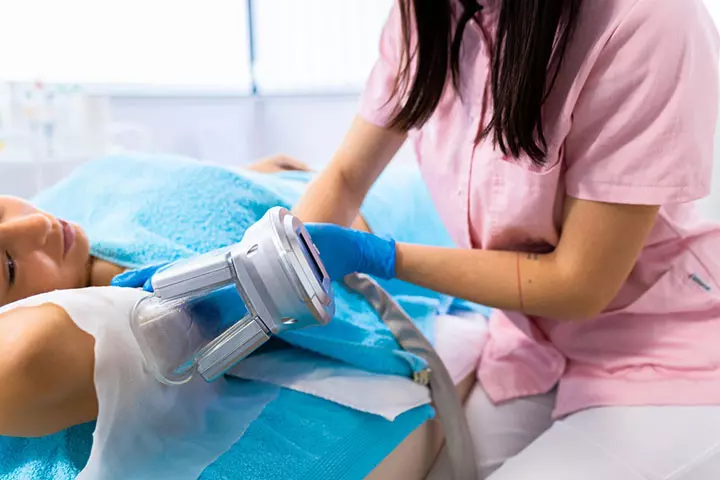
Cryolipolysis (Cool Sculpting) or cryogenic lipolysis is a method of freezing fat below the skin using a vacuum device and cool pads. It helps eliminate pockets of unwanted fat but may not be effective in eliminating cellulite.
2. Mesotherapy
Mesotherapy is a cosmetic procedure where various substances, such as caffeine, hormones, herbal extracts, or enzymes, are injected into the affected area to stimulate the production of elastin and collagen. The injections are typically administered directly into the cellulite using a fine needle.
Although there are claims that the procedure gives a positive result, it is not recommended due to side effects, such as swelling, erythema (redness), lump formation, and allergic reactions. Injection site infections and skin changes may also occur in mesotherapy.
3. Supplements
Dietary supplements such as grape seed extract, caffeine, or ginkgo lack scientific evidence for their effectiveness.
Cellulite treatments are not medically necessary. These cosmetic procedures are often associated with side effects and may require several sessions for temporary results. Many procedures may result in skin damage or may cause side effects that require medical treatment.
There is a lack of scientific evidence for some anecdotal concepts, and so skin care tips for teens such as vigorous skin massages and the consumption of certain foods to improve lymphatic flow or remove toxins to eliminate cellulite in teens are recommended.
 Point to consider
Point to considerHow To Prevent Cellulite In Teens?

Prevention of cellulite may not be possible since the causes are unknown. However here are a few ways you may keep your physical appearance and skin healthy.
- Maintaining a healthy weight and regular physical activity may help prevent cellulite in some people. If you are overweight or obese, work with a trainer to formulate an exercise plan to bring your BMI within the normal range. Eat a well-balanced diet consisting of various fruits and vegetables.
- Regular practice of aerobic and strength training exercises may aid in ensuring you have a sculpted and muscular physique, slowing down the cellulite build-up (17). You may also engage in resistance training and cardio workouts like running or cycling (7).
- Massaging with a dry, stiff-bristled brush has also been anecdotally proven to reduce the appearance of cellulite. Dry brushing the skin may have effects similar to cellulite rollers in improving blood flow in the connecting tissues and puffing up the skin. However, more research is required to prove the efficiency of the method in preventing cellulite (7).
- Wearing anti-cellulite clothing and apparel might reduce the appearance of cellulite. These apparel have bio-ceramic material that may heat up and break down the cellulite cells as and when they appear. However, more research is needed to prove the efficacy of this method in cellulite reduction or prevention (18).
- Cupping or using suction cups to pull up the skin in parts of the body has been anecdotally proven to reduce the onset of cellulite (7). It is believed that the suction created by the cups helps increase blood flow and lymphatic drainage, which may help improve skin texture and tone.
A healthy diet and adequate hydration may also help in cellulite prevention (5).
Foods That Help Fight Cellulite
There are several food times that can be consumed to help reduce cellulite and also prevent its increase. Some of these include (6):
- Flaxseed: Addition of flaxseed to one’s meals helps in boosting the growth of collagen and also prevents the formation of extra cellulite in the body.
- Water: Consuming a minimum of eight glasses of water throughout the day helps in flushing out the toxins from the body and the fat layers present beneath the skin.
- Kelp (seaweed): Consumption of kelp is known to help in burning body fat. Certain studies have also suggested that kelp can help facilitate about five to 10 loss in body weight which in turn helps in reduction of cellulite.
- Gotu kola extract: The extract of this herb has been thoroughly researched and proven to help in the reduction of cellulite.
Frequently Asked Questions
1. Is it normal to get cellulite during puberty?
Cellulite is common in puberty and is seen in nearly 80 to 90% of girls. It is possibly caused by changes in hormone levels. Further, weight gain may increase the appearance of cellulite in some people (7).
2. Can cellulite go away once it appears?
Cellulite may not go away completely, but you can improve your skin’s appearance by exercising regularly and following a healthy diet. Further, various therapies, such as laser, acoustic wave therapy, and special massage, are available to improve the skin’s appearance (7).
3. Will running get rid of cellulite in the legs?
Running may help you strengthen your leg muscles and lose excess fat, making your cellulite appear diminished. Following a healthy lifestyle and personalized resistance training along with running may help you get better results.
4. How long does it take for cellulite to appear better?
A few months of dedicated workouts and lifestyle changes may be required to notice a visible reduction in your cellulite.
5. Can working out make cellulite worse?
Working out and toning the body can make cellulite less prominent. When you lose fat and gain muscle strength, the cellulite may appear diminished (8). Experts recommend various exercises to improve the skin appearance in cellulite rather than quick fixes.
6. Is cellulite caused by dehydration?
Yes, dehydration may be considered one of the factors that cause cellulite (5).
7. What foods cause cellulite in teens?
Excessive intake of foods that contain high amounts of fats, salt, and preservatives, a sedentary lifestyle, alcohol consumption, and smoking may give rise to different adolescent health issues that may increase the risk of cellulite development (9).
8. What vitamin helps with cellulite?
Some studies show that retinoid creams (vitamin A) help in cellulite treatment if applied for six months. However, other studies show that the creams do not have any effect. Therefore, more research should be done in this field (10).
Cellulite in teens is not a condition of medical concern and does not require treatment. However, one may seek treatment for cosmetic reasons to improve the appearance of the affected area. Estrogen hormone and family history may be linked to cellulite formation more than being overweight or obese. Therapies such as acoustic wave, laser, and vacuum-assisted tissue release are available, along with creams and lotions for reducing cellulite. Make sure you consult a board-certified dermatologist before undergoing such treatments to minimize adverse effects and long-term complications.
Infographic: How To Treat Cellulite In Teens?
People of all ages, even teenagers, can develop cellulite, characterized by lumpy skin on the thighs and other body regions. Caused due to genetic, hormonal factors, and dietary causes, cellulite can be annoying and unsightly for many teens. So, look through the infographic below to learn effective ways to treat cellulite in teenagers.
Some thing wrong with infographic shortcode. please verify shortcode syntax
Illustration: Effective Treatments To Cure Cellulite In Teens
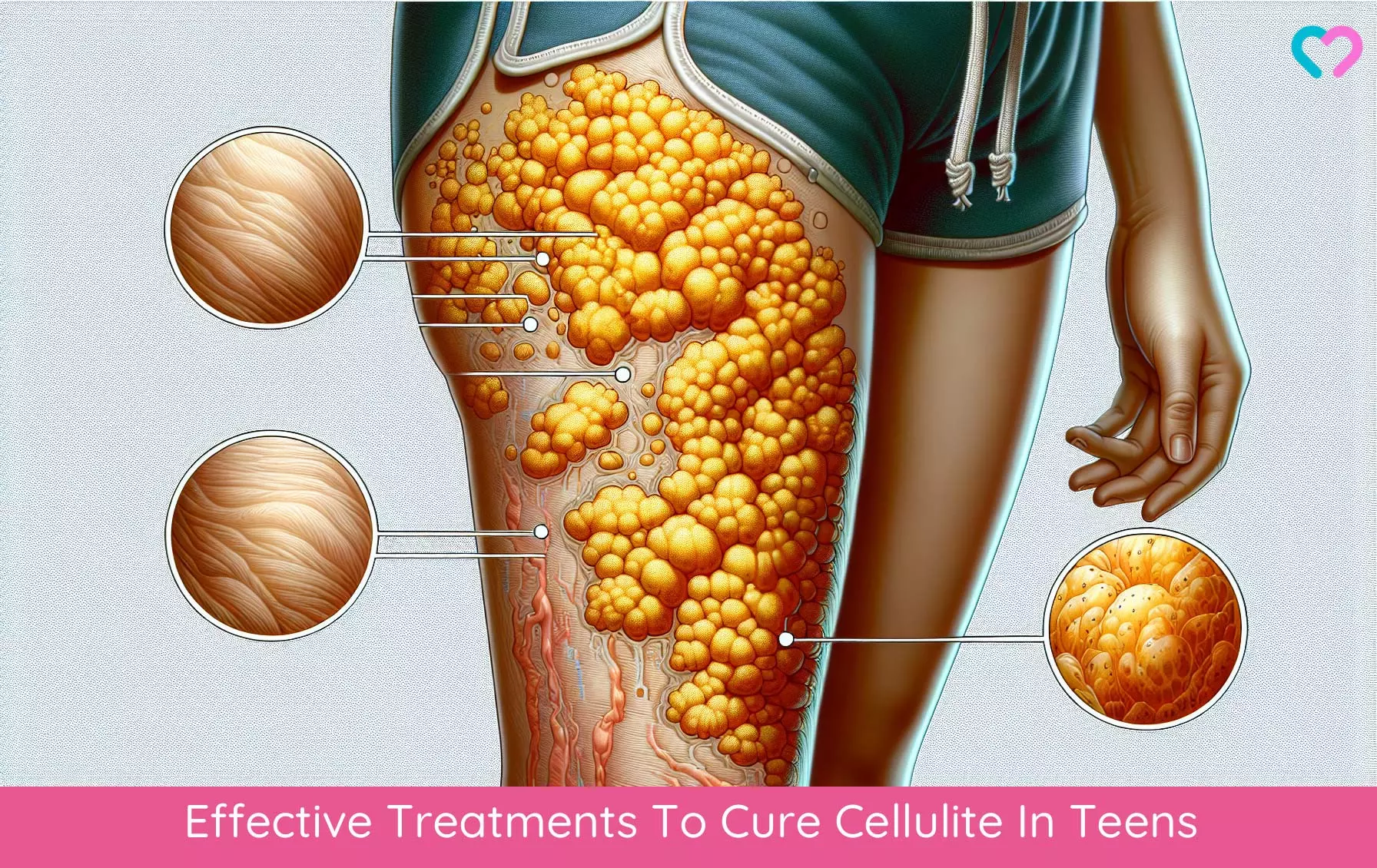
Image: Dalle E/MomJunction Design Team
Learn about the causes of cellulite and how to treat them! Discover the best ways to reduce the appearance of cellulite and get smooth-looking and healthy skin.
Personal Experience: Source
MomJunction articles include first-hand experiences to provide you with better insights through real-life narratives. Here are the sources of personal accounts referenced in this article.
i. Accepting the norm of cellulite & stretch marks;https://itsmeganelizabeth.blogspot.com/2025/06/accepting-normality-of-cellulite-and-stretch-marks.html ii. Growing up in weight loss culture;
https://andreajrzdz.medium.com/growing-up-in-weight-loss-culture-869e1805024b
References
1. Neil Sadick; Treatment for cellulite; The United States National Library of Medicine
2. Cellulite; The Australasian College of Dermatologists
3. Cellulite Treatments: What Really Works?; The American Academy Of Dermatology
4. Acoustic Wave Therapy (AWT); Clyde Injury Clinic
5. Cellulite; MedlinePlus; The United States National Library of Medicine
6. Nine Ways to Fight Cellulite; OSF Healthcare
7. Cellulite; Cleveland Clinic
8. Exercise And Cellulite; American Council on Exercise
9. Kamila Tokarska et al.; Cellulite: a cosmetic or systemic issue? Contemporary views on the etiopathogenesis of cellulite; NCBI (2018)
10. Len Kravitz and Nicole J. Achenbach; Cellulite: A Review of its Anatomy, Physiology and Treatment; University of New Mexico
11. Katharina Russe‐Wilflingseder and Elisabeth Russe;Acoustic Wave Treatment For Cellulite—A New Approach; AIP Conference Proceedings (2010)
12. Cellulite Treatments; American Board of Cosmetic Surgery
13. Nikos Adamidis, Petros Papalexis, and Sotirios Adamidis; Exploring the Link Between Metabolic Syndrome and Cellulite; Cureus (2025)
14. Allen Gabriel et al.; Cellulite: Current Understanding and Treatment; Aesthetic surgery journal (2025)
15. Kamila Tokarska et al.; Cellulite: a cosmetic or systemic issue? Contemporary views on the etiopathogenesis of cellulite; Postepy Dermatol Alergol (2018)
16. Kimi Gabriella Taira et al.; Association of Cellulitis With Obesity: Systematic Review and Meta-Analysis; JMIR Dermatol (2025)
17. Cellulite; The Nemours Foundation18.
18. Nine Ways to Fight Cellulite; OSF Healthcare System
Community Experiences
Join the conversation and become a part of our nurturing community! Share your stories, experiences, and insights to connect with fellow parents.
Read full bio of Dr. Wayne Hough

Dr. Po-Chang Hsu is a medical doctor and medical content expert. He received his medical degree from Tufts University School of Medicine in Boston in 2016. Previously, he did a master’s degree at Harvard University and wrote a thesis on neuroimaging in schizophrenia patients at Brigham and Women’s Hospital. He currently works at Alpas Wellness.
Dr. Po-Chang Hsu is a medical doctor and medical content expert. He received his medical degree from Tufts University School of Medicine in Boston in 2016. Previously, he did a master’s degree at Harvard University and wrote a thesis on neuroimaging in schizophrenia patients at Brigham and Women’s Hospital. He currently works at Alpas Wellness.
Read full bio of Dr Bisny T. Joseph
Read full bio of Swati Patwal
Read full bio of Anindita Ghatak






